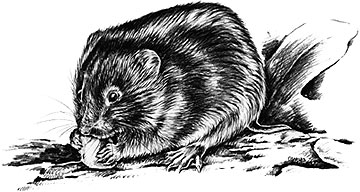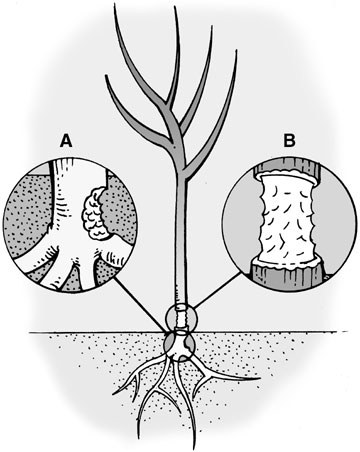 The body length of pine or woodland voles, Microtus pinetorum, varies from 3 to 5-1/2 inches.
The body length of pine or woodland voles, Microtus pinetorum, varies from 3 to 5-1/2 inches.
Pine or woodland voles
Physical characteristics
- Eyes and ears concealed
- Tail shorter than hind legs
- Fur reddish brown
- Slightly smaller than meadow and prairie voles (3 inches long, weighs 1 ounce or less)
- Lives and causes damage below the ground
Reproduction
Female pine voles have a gestation period of 24 days, have a litter size of two to three young, and produce four to six litters per year. They reach sexual maturity at 37 to 38 days and have a reproductive life span of between 15 and 18 months.
Ecology
Pine voles spend most of their lives under the ground in burrow systems. They can be found in forested areas but also inhabit fields next to woodlands. They feed on plant roots, flower bulbs, and the growing tissue (cambium) of tree roots. Pine voles tend to stay in an area as small as 1,000 square feet for their entire lives. At night, they come above the ground and feed on fruit and tender green vegetation. Soils with substantial clay content are more likely to support pine vole populations than sandy soils. Clay soils permit the development of a relatively permanent burrow system and nest chamber. The typical natural habitat for pine voles is the shrub edge between the woods and grassy field openings.
Damage identification
Pine voles damage trees and plantings below the ground. (See A.) When damage to a particular tree, shrub, or broad-leaved plant is extensive, the plant will be severely weakened and may die. The trunks of small trees or shrubs may be severed from the roots, making it possible to pull the top of the plant out of the soil. Upon close inspection of the plant, gnawing marks can be seen just under the soil line. Girdling damage usually occurs in the fall and winter. The girdling may occur on mature or seedling trees and can be differentiated from damage caused by other animals by the irregular patches and irregular angles of the bite. (See B.) These gnawing marks are about 1/16 inch wide and 3/8 inch long. The results of the damage, even if control action is taken, may carry over and affect production in following years. In apple orchards, damage to the tree may not be sufficient to kill the tree, but damaged trees produce less fruit. Careful observation beneath the tree may reveal entrance holes and tunnels that are about 11/2 inches in diameter. Look under the tree for hollow shells of apples, eaten from the underside. If pine voles are living under the tree, a network of tunnels approximately 3 inches under the soil can be located by probing with a stick or rod 1/2 to 3/4 inch in diameter.
 Figure 1
Figure 1
Pine voles damage plantings below the ground.